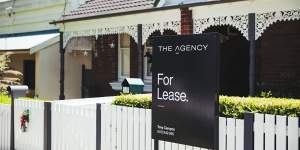Historical data shows that the country’s national vacancy rate has not fallen below 3 per cent since 2005,when the SQM Research records began. A rental market with a vacancy rate higher than 3 per cent was typically considered a renters’ market,tenancy advocacy groups said.

A vacancy rate between 2 and 3 per cent would be considered a healthy or balanced market,other experts said,which may lead to small rental price gains or even falls over a longer period of time.
The national vacancy rate was 1.2 per cent in May. In Sydney,it was 1.4 per cent and in Melbourne,it was 1.3 per cent. Nationally,rates have remained below 2 per cent since late 2021.
The national rate peaked at 2.9 per cent in April 2020 and previously reached the same peak in 2016. Sydney’s highest vacancy rate on record was 4.3 per cent in May 2020;for Melbourne,it was 5.5 per cent in December 2020.
“It’s been a unique period. On our numbers,which go back to 2005,we haven’t had a rental crisis like this in the 21st century. It’s never been this bad for our generation,” SQM Research founder Louis Christopher said.

“You’ll see some people say rent[prices] are back to where they were before COVID,but they’ve well and truly gone past that.”
Low vacancy rates have been highlighted as a major contributor to the rental crisis,but Christopher said a vacancy rate below 2 per cent alone was not enough to drive rents up rapidly.
“The period between 2010 and 2018 was a period where vacancy rates were below 2 per cent[in Sydney],” he said. “They slowly moved upwards towards the period of 2018,and they didn’t continually tighten and tighten again. Rents did rise,but they weren’t accelerating like they did in 2021.”
Christopher said the speed at which vacancy rates fell and the depths to which they sank had helped create the conditions for the current rental crisis.

Tenants Union NSW chief executive Leo Patterson Ross said a vacancy rate of 3 per cent was typically considered healthy because the Reserve Bank had determined it would allow rents to rise in line with the Consumer Price Index.
He said even a return to a vacancy rate of 3 per cent would not relieve renters from their already unaffordable rents.
“We should be aiming for historically affordable rents rather than just things not getting worse now when we’re already in a bad place,” Patterson Ross said. “That means getting to equilibrium and staying there for a long time.”
He said a vacancy rate of 2 to 3 per cent meant a rental market that would worsen.
“We need to get to 4 per cent to 5 per cent and keep it there for a few years to make housing more affordable.”
Patterson Ross said it was rare for the rental market to enter a tenants’ market,like what was seen in major cities during the lockdown periods.
“We’ve barely gone above 3 per cent,and we have a landlord’s market baked into the system,” he said. “Tenants are always competing for the landlords,which is really weird in a market system.”
Australia Institute senior economist Matt Grudnoff said the recent rental crisis had been driven by more than just economic factors. But he agreed a return to a vacancy rate between 2 and 3 per cent would limit rapid rent hikes.

The national vacancy rate has not been above 3 per cent since SQM research records began.Dion Georgopoulous
“I don’t think[vacancy rates] are necessarily the complete picture for what drives rents up,” Grudnoff said.
“People think economics and the economy is mechanical,but it’s a lot more psychological,” he said. “Over the last[few] years,there’s been a lot of permission to put prices up,which comes off the back of a very long period where there was no permission to put prices up.”
Everybody’s Home spokesperson Maiy Azize said governments needed to act to prevent a steep hike in rents in future,and adding more housing supply was unlikely to achieve the desired outcome.
“Just building without doing anything to distribute the homes or make sure they become available as rentals is not working,” she said. “It’s because housing is very unfairly distributed throughout Australia. We’ve never had more homes in Australia per adult.”
Azize favoured rent caps and building public housing as solutions to ease the rental crisis and prevent another,while Real Estate Institute of Australia president Leanne Pilkington wanted to see more housing built.
“The problem is we need more supply,and we need more investors. While the government has acknowledged these things … none of the solutions they have put forward would meet that.
“We can’t reach the[housing targets] targets because we need to bring in tradespeople to build them,but we’re not.”